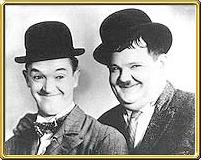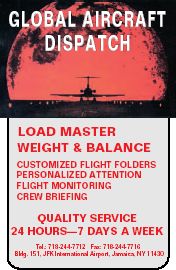|
You are currently
in the Archives section. Please be aware that some information and links
in the archived page may be outdated.
Click here
to return to the Archives' main page to see the list of archived articles.
|
A
R C H I V E S
E D I T O R I A L
History
Alive—IATA Again?
Some
day soon all of us will need a comprehensive list of the alliances and
partnerships and cooperations that have come into being during the past
few years.
This time is like none other in the history
of air cargo, as more and more transportation companies combine services.
New cargo alliances have taken on the aura
of ‘flavor of the week.’
Some place there must be a room full of
people who studied finance and mergers, whose job it is to think these
combinations up.
It’s gotten so that you need a pocket rocket
directory just to keep track of who is whose partner.
What happens (god forbid) if these deals
start to fall apart? Imagine looking for your great service combination,
only to discover that it no longer exists.
For example, there you are doing a Rip Van
Winkle, and upon waking you discover that your medicines, which DHL, Danzas
Air & Ocean and Lufthansa Cargo were shipping to you via a sensational
new strategic partnership set up to serve the pharmaceutical business
that was going great guns when you dozed off, has somehow been discontinued?
That can’t happen?
Ask the guy next to you waiting for his
Pan Am flight to Berlin.
But seriously, for now, in early October
2003 it’s the DHL, Danzas, Lufthansa pharm arrangement that is not only
on, but in shipping terms, these new life sciences transport partners,
are ready to rock.
The aim of this cooperation, (the group
acknowledges this deal can be seen as the initial stages of a joint venture),
is to offer leading clients in the life-sciences industry integrated logistics
solutions for temperature-controlled, door-to-door transportation.
The way the partners have it configured,
pharm customers will benefit considerably from a seamless (once all the
wrinkles are out) standardized service to numerous destinations around
the world.
More transparency as well as a continuous
temperature-controlled, door-to-door service adds up to added value and
better fit, according to the partners.
Well, good luck to them and in an increasingly
complex world, to us as well.
If anything changes, we hope that somebody
remembers to leave a call.
For a moment share the thoughts of an Air
Cargo News reader from the UK who has been in this business since 1969
(and wishes that his name be withheld):
“Once upon a time there was one big alliance
known as the International Air Transport Association or IATA.
This allowed an air cargo company to ship
goods via any IATA airline from their local airport to anywhere else in
the world, simply by utilizing any number of member airlines on one Air
Waybill.
Costs were detailed in the IATA Tariff,
and the revenue split between the carrying airlines on something resembling
pro-rata based on mileage.
But the airlines complained about IATA controlling
rates.
Many broke ranks to follow their own marketing
procedures.
Now a company could take their shipments
to their local airport and if they were lucky, have that cargo moved from
the nearest gateway airport to another gateway and rarely further.
Since then, there have been many failures,
many take-overs, and now several high-level alliances of the major airlines.
So what is the result?
Now a company may be able to take their
shipments to their local airport and have the cargo shipped from gateway
to gateway to gateway and rarely further.
Are we moving to a time when the airlines
will form themselves into one big alliance?
And what will they call it?
IATA?”
Another Fine
Mess
 If
Stan Laurel and Oliver Hardy were to describe it, Ollie would say: If
Stan Laurel and Oliver Hardy were to describe it, Ollie would say:
“Here’s another fine mess you’ve gotten
me into.”
A new rule from the Financial Accounting
Standards Board (FASB) wants U.S. airlines to add cost of airport bonds
to their debt load.
How great is that.
In early August it was cascading blackouts,
now the carriers are faced with cascading debt.
Airports issue municipal bonds to build
a passenger or cargo terminal, use lease payments from an airline to service
the debt and have the airline guarantee the debt.
That’s how Los Angeles World Airports and
The Port Authority of New & New Jersey and AMR for example, raised $2
billion to create AA super passenger centers at Los Angeles International
and New York’s John F. Kennedy International Airport.
But if enacted, the scheme that AMR thought
it had done and done, could add $2 billion to the company debt load that
would adversely impact already anemic balance sheets.
Is FASB nuts?
Can’t these accountants with their green
eye shades and garters on their sleeves, take some time to go to the beach,
drink some Corona and mellow out?
Maybe if they relax and smell the roses,
the experience might also serve to reawaken their other senses too.
What the airlines need now, is some world
peace and quiet plus a reliable source of electricity, so that they can
stay up some more all night, as they try and figure out how the hell to
survive.
Next they need to raise some money to tide
them over until business normalizes.
If the FASB is allowed to impact airline
balance sheets with more debt, financial markets could turn tail and head
elsewhere.
If the FASB wants to do the right thing,
how about cutting the posturing nonsense and assist the airlines in getting
a couple bucks to help cover that blackout which impacted 50 million people
and devastated airline schedules?
Why should Home Depot be the only Blackout
’03 winner?
In a Forbes article, UPS was quoted saying
something like they see nothing wrong with everybody changing their balance
sheets, since UPS already does it the FASB way.
To that we say:
Shut up already, UPS.
|
|
As
we ready ourselves for the fall after having celebrated the day
that celebrates working stiffs everywhere, called simply Labor Day,
“The Copilot”
The poem that originally appeared
in the October 1942 issue of “The Air Line Pilot”, the monthly magazine
of the Air Line Pilots Association (ALPA), was created in 1941 by
Keith Murray, a captain with Colonial Airlines.
Later Colonial became part of American
Airlines.
But imagine for a moment, a different
time and place.
It is a late August Sunday in 1941.
Although war is raging elsewhere,
and one Sunday four months hence will come by surprise onto American
soil, this Colonial morning flight, bound for Boston, is a Douglas
DC3 which cruises at an altitude of 5600 feet at 165 mph.
Outside and below, things are quiet.
The roads are sparsely traveled because
it is Sunday.
Flight crews and passengers loved
Sunday flights. The pace was slower and you could always tell what
day of the week it was because most of the cars were parked around
the churches that were clearly seen along the route.
It was a different time and place,
and as mentioned, a mood soon to be broken forever.
“The Copilot”
I am the copilot.
I sit on the right.
It’s up to me to be quick and bright,
I never talk back for I have regrets,
But I have to remember what the Captain forgets.
I make out the
Flight Plan and study the weather,
Pull up the gear,
Stand by to feather,
Make out the mail forms and do the reporting,
And fly the old crate while the Captain is courting.
I take the readings,
adjust the power,
Put on the heaters when we’re in a shower,
Tell him where we are on the darkest night,
And do all the bookwork without any light.
I call for my
Captain and buy him cokes,
I always laugh at his corny jokes,
And once in a while when his landings are rusty
I always come through with, “By gosh it’s gusty!”
All in all,
I’m a general stooge,
As I sit on the right of the man I call “Scrooge”,
I guess you think that it’s past understanding,
But maybe some day he will give me a landing.
|

|


